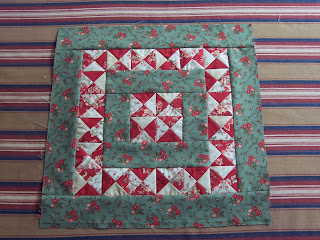Ask Monique - Quitling Ann Landers
Happy Monday!
Sorry that I didn't blog last week but it was a busy week. I lectured in Decatur, Illinois at the Decatur County Quilt Guild. Everyone was so wonderful and I had a great time.
On Friday, I left for New Hampton, IA to demo my rulers at my friend, Denise's quilt shop, Quilter's Window. She was involved in a 9 bus tour and we had over 400 ladies come through her shop. It was a great turnout and it looked like everyone had a blast! They got to travel to different shops in Minnesota, Wisconsin, Illinois and Iowa on a 2 day bus tour. Everyone that came through seemed to enjoy the experience. I know that I enjoyed meeting everyone! I'm sure she will do it again so look for a bus tour at your local shop.
I had every intention of writing my new Ask Monique column last Monday but as you see it was a crazy week. So, I decided to do it this Monday. My first question comes from Tracey and she asks:
Sorry that I didn't blog last week but it was a busy week. I lectured in Decatur, Illinois at the Decatur County Quilt Guild. Everyone was so wonderful and I had a great time.
On Friday, I left for New Hampton, IA to demo my rulers at my friend, Denise's quilt shop, Quilter's Window. She was involved in a 9 bus tour and we had over 400 ladies come through her shop. It was a great turnout and it looked like everyone had a blast! They got to travel to different shops in Minnesota, Wisconsin, Illinois and Iowa on a 2 day bus tour. Everyone that came through seemed to enjoy the experience. I know that I enjoyed meeting everyone! I'm sure she will do it again so look for a bus tour at your local shop.
I had every intention of writing my new Ask Monique column last Monday but as you see it was a crazy week. So, I decided to do it this Monday. My first question comes from Tracey and she asks:
Most patterns say 1/4 inch seam, some say scant 1/4 inch seam.
What is the difference? How do I achieve the perfect 1/4 inch or scant
1/4? and why 1/4 inch?
ok maybe thats 3 ?'s
Dear Tracey:
What is the difference between a scant 1/4" seam and a 1/4" seam and what do you use?
It is actually a scant 1/4" seam. The full 1/4" is measured from the side of your thread to the edge of the fabric. If you sew a scant 1/4", you measure your 1/4" and include your threads. The reason that you need to use a scant 1/4" seam is if you use a full 1/4" seam, then the fold from pressing and thread width will make up a little bit of bulk and your 1/4" becomes a fat 1/4".
How do you achieve the perfect scant 1/4"?
First, it depends on the type of foot you are using. If you use a 1/4" foot, you will need to be just inside the foot, not where you can see your fabric. If you are using a regular foot and move your needle to the correct position, then you need to make sure that you sew several test pieces to make sure that you are achieving your 1/4". How you do this is, sew a piece in different positions of your needle, measure and ascertain which is the correct scant 1/4". It's a great idea to do this for any foot that you use.
Second, there is a really great tool by Perkins Dry Goods that helps you achieve the perfect 1/4" seam. It is called the Perfect Piecing Seam Guide. Check it out.
Why 1/4"?
That is a good question, Tracey! I don't really know but it seems that it's always been a 1/4" in quilting. Maybe to reduce the bulk for smaller pieces? That makes sense to me.
Thanks for the great question and continue to write in with them!
See you Wednesday for Block #5 of the Blogger Girls Block of the Month!



Comments
It really doesn't matter. Yep, that's right, it really doesn't matter.
Your quilt just has to have the same size seams in each block for it all to fit together with precision.
It took me many years of quilting to realize this.
It doesn't matter if your seams or 1/4 inch, 1/2 inch, or somewhere in between. Just as long as they are all the same size.
Sandy